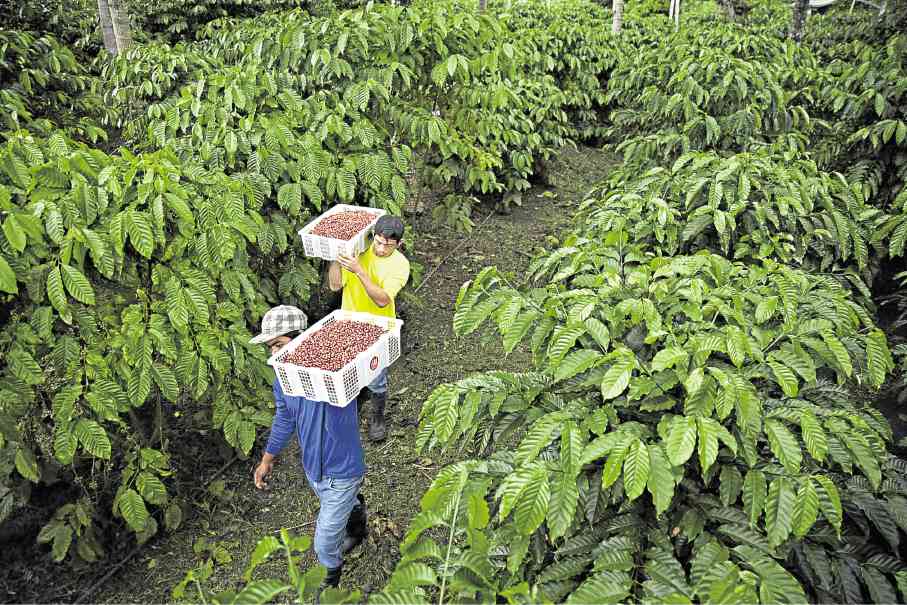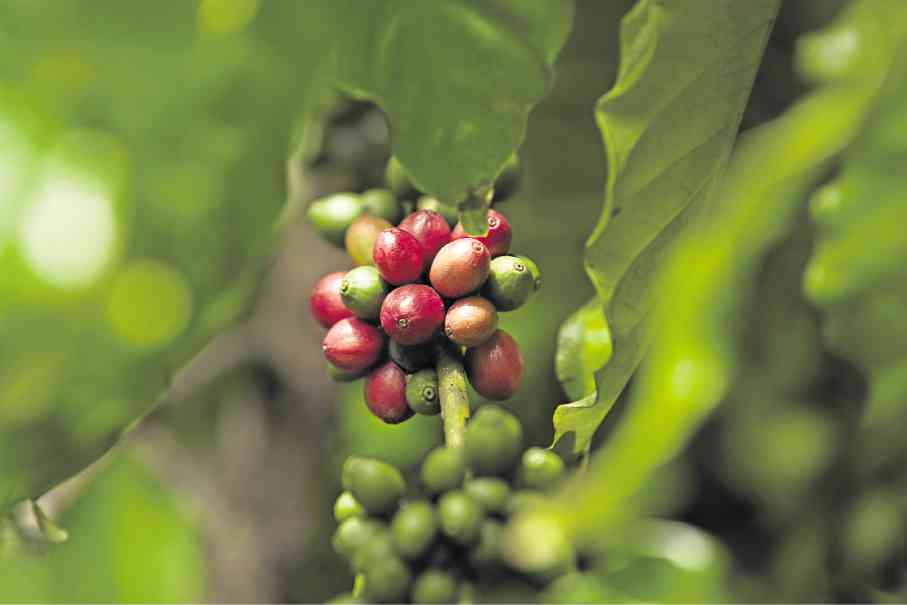How we bought a farm and almost proved the idiom true

GOOD HARVEST Workers gather ripe berries for processing, starting with a water bath. Photos by JC and Anna Valencia
Call it a family affair. My husband and my grandparents had plantations in the South so we thought we’d buy raw agricultural land in Batangas and develop our own little farm.
We also wanted our sons to feel a connection to the earth and eat less grocery-sourced food. For myself, I wanted to produce our own food, free from pesticides and harmful chemicals.
So after some 20 years of writing for various publications, I was ready to re-invent myself as a farmer, eager to apply all I’ve learned from interviewing environmentalists, agriculturists, agronomists, traditional and permaculture farmers. One thing was clear: We were going to keep everything as close to its natural state as possible.
The property we bought at the foot of Mt. Malarayat in Batangas had been neglected by its previous owner—in a good way. It was virtually untouched jungle. No one had chopped down the trees to turn them into charcoal or slashed and burned everything in sight to plant short term crops. The soil was very fertile. There was also a healthy population of wildlife including red fire ants the size of buses. At least that’s what their bites felt like.
Article continues after this advertisementDream farm
Article continues after this advertisementDeveloping raw land is like entering a tunnel with blazing club lights. You’re raring to go even if you’re not quite sure how much juice you’ll need to power those lights to get to the end of the tunnel. The thought that we’d be sinking a sizeable chunk of our nest egg didn’t faze us, as we were excited to transform unproductive land into our dream farm.
Working alongside the locals we hired to clear the land, we made sure they only cut what wasn’t useful. And because they were young and didn’t know which plants, herbs and flowers were edible or can be used to repel insects, we gave them quick lessons on folk medicine, composting, and even Filipino vegetable dishes that can be plucked from the land.
In turn, they snickered when I returned from the forest with poisonous mushrooms and ferns I had meant to cook. Lesson No. 1, don’t be so smug just because you have unlimited access to the Net.
In lieu of an architect and contractor, we relied on our longtime foreman and his team of rural laborers who got crash courses as well on environmental conservation and recycling. We had to install electrical posts and water connections immediately since the charm of living like Tarzan and Jane for weeks was starting to fade. It didn’t help that locals regaled our staff with scary stories about a tikbalang, the ghostly White Lady and other aswang lurking in the dark.
I was more concerned Mr. Tikbalang and his ghoulish squad might haul away all our copper wire, PVC pipes and bags of cement while my men hunkered down in their tents at night.
At the start, we were elated with our homegrown production, but as the produce turned out to be too much too soon, I began to detest the pressure to sell before the harvest rotted. Solution: Use the greens in all ways imaginable: Lettuce in sinigang and nilaga isn’t all that bad.
Pedigreed coffee
For our commercial crop, we decided on coffee not only because it’s a nonperishable high value cash crop, but also because we saw a romantic side to coffee farming. We paid premium for coffee seedlings grown in a nursery in Bukidnon since provenance was important to produce excellent coffee cherries. Think pedigreed coffee trees.
We weren’t exactly taking a step into the unknown but as coffee drinkers, all we knew about coffee was that we want the brew strong, aromatic and bracing. As coffee farmers, here are some stuff that we learned: Coffee seedlings need daily attention and proper nutrition. Caring for them is extremely labor extensive and it costs more to raise them organically. Their needs change by the week and at different stages of their growth.
At 2 1/2 feet high, the seedlings have to be bent and the ends tied to a bamboo peg stuck in the ground with nylon string. After a few weeks, new branches will sprout from the bent branch. Three of the new branches need to be tied to bamboo formed like a triangle so the coffee plants would resemble the shape of Christmas trees when they mature. When the three new branches are established, the bent branch can be cut. Now imagine having to do this on over 3,000 trees.
What else did we learn? That compost and organic fertilizer should be added regularly. That vermiculture entails feeding worms well lest they crawl away from home. That investing in farm equipment and training farm staff to take care of them are a must. That coffee seedlings need to be hand watered daily if it’s not rainy season, with double or even triple the amount of water in the summer. Investing in an automated drip irrigation system can cost several thousands but definitely worth it especially on adult coffee trees.
Farm owners too have to contend with natural calamities.
In 2014, the farm was directly hit by Typhoon “Glenda,” which severely damaged the farm including the main house and reservoir pond. Some 80 percent of the large nonnative trees that shaded the coffee seedlings were uprooted and half of the juvenile trees died due to flying debris. Repairs and replanting cost nearly a million, a sum that others in the barangay who similarly lost their crops didn’t have.
‘Leisure farming’
I thought of calling the Department of Agriculture to provide the farmers with free seeds so they could start over. Soon enough, three shady-looking characters from the DA Quezon City office showed up at my farm and insisted that I accept a free carabao from them instead. I desisted. But to this day, I still have no idea how a request for vegetable seeds turned into a carabao which I did not need as the farm was fully mechanized.
It set me thinking: Is the term leisure farming an oxymoron? Do city slickers know what they’re getting into when they decide to settle into the countryside and start a rustic life? Growing one’s own food isn’t as economical as it all sounds, I found out. During our worst moments, I contemplate the idiom, “bought the farm,” surprised that it meant “dying” or “dead.” Apparently, whoever thought up the idiom had some experience in farming. One feels like expiring when faced with the challenges that go into working the land.
For one, crop insurance premiums cost too much while agricultural loans have high interest rates. Crop prices meanwhile fluctuate, depending on so many factors. The price of green coffee beans for instance can go from a low of P80 to a high of P100 per kilo. Farmers also need extra labor or pickers when the coffee cherries are ripe enough to be harvested. You can’t just harvest a whole field in one swipe; it takes several rounds of picking. Yet more labor is needed to sort the green beans according to size and quality. Since we are a single origin estate farm of stand alone Robusta, every bean must be carefully chosen.
It might’ve been easier if we were members of a co-op but we’re the only coffee farmers in our district—for various reasons. Like any business venture, it takes commitment and faith in your crop to be a successful farmer and agri-preneur. Being at the mercy of mother nature makes it more challenging and nerve wracking, and tests one’s faith in government and its capacity—even willingness—to respond to the needs of affected farmers.
Finca del Carmen
To make a profit, we roast and pack our own coffee under the Finca del Carmen Single Origin Estate Coffee brand, named in honor of my mother in law, Maria del Carmen and her patroness, Our Lady of Mt. Carmel. She grew up in Bicol where Filipino ancestral homes inspired the design of the label. I also took some details from Juan Luna’s Tampuhan oil painting. Artist Jo Tripon Factoran put it all together.
Seeing our product in well-designed packs ready for delivery to store shelves is one reward of farming. There are others. It’s a lifestyle where you obviously can have the farm to table experience everyday. It’s no exaggeration to say that when you share the greens you yourself planted and harvested, you also feed your soul. Because there are many moments between the frenetic planting, harvesting and repairs when you can literally just sit back and smell the flowers—which, in the case of coffee, smell and look like jasmine.
Above everything else, being a farmer is a humbling experience and makes one grateful for the little things that turn out right, in our case, having met coffee experts and long time entrepreneurs like Vie and Basil Reyes of Bote Central who’ve been very encouraging and generous with their knowledge, and Dr. Joe Reano, Nestle’s retired agronomist who helped keep our trees healthy.
Then there’s the feeling that you’ve made a positive change in the lives of your staff, as they become part of your team and get a percentage from sales. It’s not the caffeine that gives us a high when we walk around the coffee plantation at sunrise, sipping coffee. Everything feels so right despite all the hit and misses through the years, from the first check we got from our first harvest (P5,000, and it felt like winning the lotto) to the current earnings and profits that encourage us to go on.
Would I do it all again? Yes, of course. My grandparents said the best fertilizer for any plantation are your footprints. I agree but having an ice cold beer and watching a beautiful sunset at the end of the day helps too.
I only wish I could be as upbeat as storyteller Isak Dinesen (Danish author Karen Blixen) and say in a throaty, confident voice : “I had a farm in Batangas,” and forthwith regale readers with tales of romance amid the fragrant coffee blossoms.



